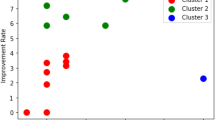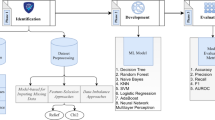Abstract
This paper describes the developmental process of a machine learning-based prediction system to evaluate autism Improvement level (MPredA), where the concerned user (parents or clinical professionals) can evaluate their children’s development through the web application. We have deployed our previous work (mCARE) data from Bangladesh for prediction models. This system can predict four major milestone parameter improvement levels of children with ASD. In this four-broad category, we have classified into four sub-milestones parameters for each of them to predict the detailed improvement level for each child with ASD. This MPredA can predict 16 milestone parameters for every child with ASD. We deployed four machine learning algorithms (Decision Tree, Logistic Regression, K-Nearest Neighbor, and Artificial Neural Network) for each parameter with 1876 data of the children with ASD to develop 64 prediction models. Among the 64 models, we selected the most accurate 16 models (based on the model’s accuracy and evaluation scores) to convert pickles file for the MPredA web-based application. For the prediction system, we have determined the most ten important demographic information of the children with ASD. Among the four-machine learning algorithms, the decision tree showed the most significant result to build the MPredA web-based application. We also test our MPredA -web application by white box testing and get 97.5% of accuracy with real data.
Access this chapter
Tax calculation will be finalised at checkout
Purchases are for personal use only
Similar content being viewed by others
Abbreviations
- Autism Spectrum Disorder (ASD): :
-
Behavioral development disability among the children at an early age
- Milestone Parameter (MP): :
-
The list of early age children’s behavioral achievement
References
Kanner, L.: Autistic disturbances of affective contact. Acta Paedopsychiatr. 35(4), 100–136 (1968)
Tariq, Q., et al.: Detecting developmental delay and autism through machine learning models using home videos of Bangladeshi children: development and validation study. J. Med. Internet Res. 21(4), e13822 (2019)
Wallace, G.L., et al.: Real-world executive functions in adults with autism spectrum disorder: profiles of impairment and associations with adaptive functioning and co-morbid anxiety and depression. J. Autism Dev. Disord. 46(3), 1071–1083 (2016)
W. H. Organization. Autism spectrum disorders. https://www.who.int/news-room/fact-sheets/detail/autism-spectrum-disorders. Accessed 30 June 2021
Sealey, L., et al.: Environmental factors in the development of autism spectrum disorders. Environ. Int. 88, 288–298 (2016)
DiGuiseppi, C.G., et al.: Demographic profile of families and children in the Study to Explore Early Development (SEED): case-control study of autism spectrum disorder. Disabil. Health J. 9(3), 544–551 (2016)
S. A. Autism Statistics and Facts. autism speaks. https://www.autismspeaks.org/autism-statistics-asd. Accessed 9 June 2021
Happé, F.G., Mansour, H., Barrett, P., Brown, T., Abbott, P., Charlton, R.A.: Demographic and cognitive profile of individuals seeking a diagnosis of autism spectrum disorder in adulthood. J. Autism Dev. Disord. 46(11), 3469–3480 (2016)
Gona, J.K., et al.: Parents’ and professionals’ perceptions on causes and treatment options for autism spectrum disorders (ASD) in a multicultural context on the Kenyan coast. PLoS ONE 10(8), e0132729 (2015)
N. A. A. MOM. “Is Autism a Gift or a Curse?. https://notanautismmom.com/2018/12/20/perspective/. Accessed 30 June 2021
Sommer, M., et al.: False belief reasoning in adults with and without autistic spectrum disorder: Similarities and differences. Front. Psychol. 9, 183 (2018)
Zwaigenbaum, L., et al.: Early identification of autism spectrum disorder: recommendations for practice and research. Pediatrics 136(Supplement 1), S10–S40 (2015)
C. f. D. Control and Prevention.Treatment and intervention services for autism spectrum disorder (2019)
Liu, Y., et al.: Knowledge, attitudes, and perceptions of autism spectrum disorder in a stratified sampling of preschool teachers in China. BMC Psychiatry 16(1), 1–12 (2016)
Liu, K., Zerubavel, N., Bearman, P.: Social demographic change and autism. Demography 47(2), 327–343 (2010)
King, M.D., Fountain, C., Dakhlallah, D., Bearman, P.S.: Estimated autism risk and older reproductive age. Am. J. Public Health 99(9), 1673–1679 (2009)
Zwaigenbaum, L., Bryson, S., Garon, N.: Early identification of autism spectrum disorders. Behav. Brain Res. 251, 133–146 (2013)
Barbaro, J., Halder, S.: Early identification of autism spectrum disorder: current challenges and future global directions. Curr. Dev. Disord. Rep. 3(1), 67–74 (2016)
Haque, M.M., et al.: Grant report on mCARE: mobile-based care for children with Autism Spectrum Disorder (ASD) for Low-and Middle-Income Countries (LMICs). J. Psychiatry Brain Sci. 6 (2021)
Haque, M.M., et al.: Informing developmental milestone achievement for children with autism: machine learning approach. JMIR Med. Inf. 9(6), e29242 (2021)
Maenner, M.J., Yeargin-Allsopp, M., Van Naarden Braun, K., Christensen, D.L., Schieve, L.A.: Development of a machine learning algorithm for the surveillance of autism spectrum disorder. PLoS ONE 11(12), e0168224 (2016)
U. Lab. MPredA: A machine learning based prediction system to evaluate the autism level improvement. http://mpreda.ubicomp.us/. Accessed 4 July 2021
Haque, M.M., et al.: Towards developing a mobile-based care for children with autism spectrum disorder (mCARE) in low and middle-income countries (LMICs) like Bangladesh. In: 2020 IEEE 44th Annual Computers, Software, and Applications Conference (COMPSAC), pp. 746–753. IEEE (2020)
O Solution. National Institute of Mental Health (NIMH). The National Institute of Mental Health. Accessed 29 June 2021
IPNA: The Institute of Pediatric Neuro-disorder and Autism. http://ipnabsmmu.edu.bd/. Accessed 29 June 2021
Awfbd. Autism Welfare Foundation. https://awfbd.org/. Accessed 29 June 2021
Nishpap. Nishpap Autism Foundation. https://nishpap.org/. Accessed 29 June 2021
Acuña, E., Rodriguez, C.: The treatment of missing values and its effect on classifier accuracy. In: Banks, D., McMorris, F.R., Arabie, P., Gaul, W. (eds.) Classification, clustering, and data mining applications, pp. 639–647. Springer, Berlin, Heidelberg (2004). https://doi.org/10.1007/978-3-642-17103-1_60
Zhu, X., Zhang, S., Jin, Z., Zhang, Z., Xu, Z.: Missing value estimation for mixed-attribute data sets. IEEE Trans. Knowl. Data Eng. 23(1), 110–121 (2010)
s.-l. developers. MinMaxScaler. https://scikit-learn.org/stable/modules/generated/sklearn.preprocessing.MinMaxScaler.html. Accessed 29 June 2021
Singh, D., Singh, B.: Investigating the impact of data normalization on classification performance. Appl. Soft Comput. 97, 105524 (2020)
Jo, J.-M.: Effectiveness of normalization pre-processing of big data to the machine learning performance. J. Korea Inst. Electron. Commun. Sci. 14(3), 547–552 (2019)
Sánchez-Maroño, N., Alonso-Betanzos, A., Tombilla-Sanromán, M.: Filter methods for feature selection – a comparative study. In: Yin, H., Tino, P., Corchado, E., Byrne, W., Yao, X. (eds.) IDEAL 2007. LNCS, vol. 4881, pp. 178–187. Springer, Heidelberg (2007). https://doi.org/10.1007/978-3-540-77226-2_19
Shaikh, R.: Feature selection techniques in machine learning with Python. https://towardsdatascience.com/feature-selection-techniques-in-machine-learning-with-python-f24e7da3f36e. Accessed 29 June 2021
Liang, R.: Feature selection using Python for classification problems. https://towardsdatascience.com/feature-selection-using-python-for-classification-problem-b5f00a1c7028. Accessed 29 June 2021
Gu, Z., Eils, R., Schlesner, M.: Complex heatmaps reveal patterns and correlations in multidimensional genomic data. Bioinformatics 32(18), 2847–2849 (2016)
Azhagusundari, B., Thanamani, A.S.: Feature selection based on information gain. Int. J. Innovative Technol. Exploring Eng. (IJITEE) 2(2), 18–21 (2013)
Oh, S.: A new dataset evaluation method based on category overlap. Comput. Biol. Med. 41(2), 115–122 (2011)
Safavian, S.R., Landgrebe, D.: A survey of decision tree classifier methodology. IEEE Trans. Syst. Man Cybern. 21(3), 660–674 (1991)
R.E. Wright: Logistic regression (1995)
Peterson, L.E.: K-nearest neighbor. Scholarpedia 4(2), 1883 (2009)
Wang, S.-C.: Artificial neural network. In: Interdisciplinary computing in java programming, pp. 81–100. Springer, Boston (2003). https://doi.org/10.1007/978-3-662-44725-3_5
Vabalas, A., Gowen, E., Poliakoff, E., Casson, A.J.: Machine learning algorithm validation with a limited sample size. PLoS ONE 14(11), e0224365 (2019)
Moriasi, D.N., Arnold, J.G., Van Liew, M.W., Bingner, R.L., Harmel, R.D., Veith, T.L.: Model evaluation guidelines for systematic quantification of accuracy in watershed simulations. Trans. ASABE 50(3), 885–900 (2007)
Peterson, A.T., Papeş, M., Eaton, M.: Transferability and model evaluation in ecological niche modeling: a comparison of GARP and Maxent. Ecography 30(4), 550–560 (2007)
Brownlee, J.: Save and load machine learning models in Python with scikit-learn. https://machinelearningmastery.com/save-load-machine-learning-models-python-scikit-learn/. Accessed 29 June 2021
AWS. Amazon web Service. https://aws.amazon.com/. Accessed 29 June 2021
Django. Django makes it easier to build better web apps more quickly and with less code. https://www.djangoproject.com/. Accessed 29 June 2021
SQLite. What Is SQLite?. https://www.sqlite.org/index.html. Accessed 29 June 2021
Ostrand, T.: White‐Box testing. Encycl. Softw. Eng. (2002)
s.-l. developers. A decision tree classifier. https://scikit-learn.org/stable/modules/generated/sklearn.tree.DecisionTreeClassifier.html. Accessed 29 June 2021
s.-l. developers. Logistic Regression (aka logit, MaxEnt) classifier. https://scikit-learn.org/stable/modules/generated/sklearn.linear_model.LogisticRegression.html. Accessed 29 June 2021
s.-l. developers. Classifier implementing the k-nearest neighbors vote. https://scikit-learn.org/stable/modules/generated/sklearn.neighbors.KNeighborsClassifier.html. Accessed 29 June 2021
fchollet. The Sequential model. https://keras.io/guides/sequential_model/. Accessed 29 June 2021
Varoquaux, G., Buitinck, L., Louppe, G., Grisel, O., Pedregosa, F., Mueller, A.: Scikit-learn: Machine learning without learning the machinery. GetMobile: Mob. Comput. Commun. 19(1), 29–33 (2015)
P.S. Foundation. python. https://www.python.org/. Accessed June 2021
P. Jupyter, Jupyter. https://jupyter.org/. Accessed 29 June 2021
Anaconda, I.: Anaconda Navigator. https://docs.anaconda.com/anaconda/navigator/. Accessed 29 June 2021
Acknowledgement
This study has been partially supported by an NIH grant (1R21MH116726–01). The authors are thankful to 4 specialist autism health care centers and institutions in Bangladesh: The Institute of Pediatric Neuro-disorder & Autism (IPNA) Bangladesh, The National Institute of Mental Health (NIMH), Autism Welfare Foundation (AWF), and Nishpap Autism Foundation and their respective departments for their continuous support throughout this study.
Author information
Authors and Affiliations
Corresponding author
Editor information
Editors and Affiliations
Ethics declarations
Conflicts of Interest
None declared.
Rights and permissions
Copyright information
© 2022 ICST Institute for Computer Sciences, Social Informatics and Telecommunications Engineering
About this paper
Cite this paper
Rabbani, M. et al. (2022). MPredA: A Machine Learning Based Prediction System to Evaluate the Autism Level Improvement. In: Lewy, H., Barkan, R. (eds) Pervasive Computing Technologies for Healthcare. PH 2021. Lecture Notes of the Institute for Computer Sciences, Social Informatics and Telecommunications Engineering, vol 431. Springer, Cham. https://doi.org/10.1007/978-3-030-99194-4_26
Download citation
DOI: https://doi.org/10.1007/978-3-030-99194-4_26
Published:
Publisher Name: Springer, Cham
Print ISBN: 978-3-030-99193-7
Online ISBN: 978-3-030-99194-4
eBook Packages: Computer ScienceComputer Science (R0)




